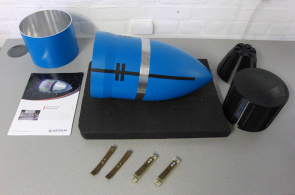High-speed tests demonstrate space penetrator concept
19 August 2013
Tests are being carried out under a technology development programme for planetary penetrators to assess the feasibility of delivering instrument packages to the subsurface of a planet or icy satellite at high speed.Traditionally, rovers or landers are delivered to the surface of a planet or moon, where a slow, careful descent is required, and where drilling or digging into the subsurface requires additional payload. But engineers are looking at an alternative way to access the subsurface.
Planetary penetrators delivered directly into the top 3 metres of the surface of a planet or moon offers such an alternative. At around 20 kilograms each, a suite of penetrators with identical payloads could be deployed across a wide surface area to yield key information about the body's interior.
To test the feasibility of such a mission payload, a penetrator study is being carried out as part of ESA's Core Technology Programme for Cosmic Vision, under the supervision of the Future Missions Preparation Office. Two high-speed impact tests were carried out at the rocket sled test facility at the Military of Defence Pendine site in Wales, United Kingdom in July, to test the integrity of the penetrator shell. Astrium UK is leading the high-speed impact study, with additional support from the Mullard Space Science Laboratory (MSSL), Qinetiq and Rapid Space Technologies.
The penetrators
 |
| Penetrator components. Credit: Astrium Ltd |
Two penetrators were prepared for impacts into sand – as an analogue for martian soil – and ice, as an analogue for icy satellites.
Each penetrator has a mass of 20 kg and measures 400 mm long and 200 mm wide. A hollow cylindrical section about 200 mm long is added to the rear to add aerodynamic support. The outer shell is made from steel and the inner bays from aluminium to contain the payload. This optimises the strength/weight ratio of the penetrator such that the outer steel shell offers protection from the initial impact, while aluminium is sufficient for internal protection.
A spring mechanism isolates the payload components from the outer skin in order to maintain a vacuum gap to provide thermal insulation – a critical component for maintaining battery and instrument lifetime in cold conditions.
For the purpose of July's tests the payload comprised a non-operational sampling mechanism that would be used to retrieve samples of rock or ice for analysis inside the penetrator. In a full-scale mission the sampling mechanism would be capable of retrieving several samples of a few grams each, up to a distance of 10-20 cm from the outside wall of the penetrator.
Accelerometers and a data logging system were activated to monitor the accelerations experienced by the penetrator as it impacted and travelled into the targets.
During the firing test, each penetrator was accelerated along a 300 m stretch of the 1.5 km rocket sled track under the power of 12 solid rocket boosters to an impact speed of over 300 m/s. The duration of the test, from firing to impact, took about 1.5 seconds. The penetrators experienced a deceleration of 24 000 g.
In both the ice and sand tests the target materials were enclosed by concrete blocks and steel girders to contain the impact hazard zone.
Impact into ice
The first test was carried out on 11 July into ten tonnes of ice. Individual ice blocks measuring 1m × 0.5m × 0.3 m were sealed together into a structure measuring roughly 2.5m × 2.5m × 3m.
| Penetrator impact into ice. Credit: Qinetiq and ESA. Click here for further details and larger versions of this video. |
Upon impact, the ice shattered and was immediately reduced to a pile of crushed ice by the shock wave generated by the impact. The penetrator travelled further into the ice than expected, striking the top of the container and nearly reaching the back wall.
The penetrator was retrieved intact but with some damage to the rear where it struck the steel beam in the roof.
Impact into sand
The second test was carried out on 16 July into 200 tonnes of fine-grained sand, compacted into a volume space measuring 7m × 3.5m × 3.5 m. A thin piece of wood covered the entry point of the penetrator to maintain a flat impact surface, and does not interfere with the impact process at these high speeds.
| Penetrator impact into sand. Credit: Qinetiq and ESA. Click here for further details and larger versions of this video. |
The penetrator reached a depth of 1 m and travelled 1 m upwards. It was retrieved intact, but scratched from sand-blasting.
In both tests the angle of impact was around 22 degrees, much greater than the maximum 8 degree tilt upwards of the penetrator that was anticipated from the modelling. It was most likely caused by an aerodynamic effect of a horizontal release and impact, and the short aspect ratio of the penetrator.
Testing in the coming weeks will reveal exactly how the penetrator's internal structure, including the thermal insulation, survived the impact.
The next main phase of the development is targeted to start at the end of 2013 and will focus on the survivability of the battery and communications systems during high-speed impacts.
About the Future Missions Preparation Office
The Future Missions Preparation Office (SRE-F) is responsible for the formal Agency studies, and for the technology preparation, of science missions that have been selected as candidates for the Cosmic Vision and Robotic Exploration Programmes. In addition, the office supports studies of enabling technologies for future missions, carried out as part of ESA's Core Technology Programme (CTP) and Exploration Technology Programme (ETP).



